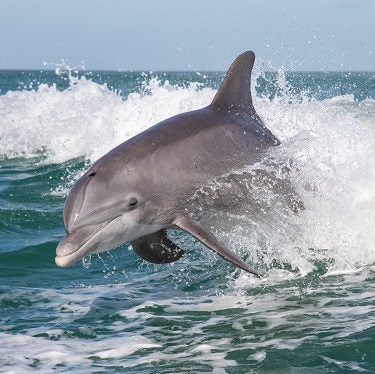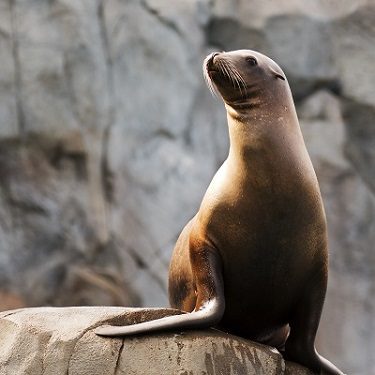Marine Life Encyclopedia
Marine Mammals
Common Bottlenose Dolphin
Tursiops truncatus
Distribution
Worldwide in tropical to subpolar latitudes
eCOSYSTEM/HABITAT
Coastal to open ocean (pelagic)
FEEDING HABITS
Active predator
TAXONOMY
Order Cetacea (whales and dolphins), Family Delphinidae (dolphins)
Coastal populations of common bottlenose dolphins are more territorial and utilize a larger number of coastal habitats – from bays and estuaries to seagrass beds, beaches, and other ecosystems. Oceanic populations are more migratory in nature and apparently do not visit coastal ecosystems.
Common bottlenose dolphins can be quite large, reaching weights of up to 1400 pounds (~640 kg) and lengths of 12.5 feet (~4 m). They are relatively long-lived (40-50 years) and reach sexual maturity at ages between 5 and 14 years old. Some individuals are known to be reproductively active for their entire lives, a rare characteristic among mammals. Like all mammals, common bottlenose dolphins reproduce through internal fertilization, and females give birth to live young. Juveniles are able to swim from the moment they are born, but they are totally dependent on nursing their mothers’ milk for nearly two years.
Common bottlenose dolphins and other dolphins are thought to be some of the smartest animals on the planet, challenging the great apes (chimps and gorillas) for the top spot. They are also extremely curious and often approach people to investigate. Their intelligence is likely both a result of and a driver of their complex social structures. They generally live in small groups and organize complex, group behaviors when mating and hunting. Their preferred prey includes small, schooling fishes and squids. Adult common bottlenose dolphins have no known predators, and juveniles are likely only rarely taken by large sharks or perhaps other predatory marine mammals.
This species is hunted for human consumption and for use as fishing bait in several places around the world, but global numbers are generally considered to be in good shape. Population trends for common bottlenose dolphins are not well known, but scientists believe this dolphin to be a species of least concern. In the United States and some other places, the common bottlenose dolphin is given complete legal protection as a result of it being a highly intelligent, marine mammal.
Fun Facts About Common Bottlenose Dolphins
1. Common bottlenose dolphins grow up to 13 feet (4 m) long and 1,300 pounds (590 kg).
2. Common bottlenose dolphins live for 40 to 60 years.
3. Female bottlenose dolphins give birth to a calf every 3 to 6 years after a 12-month gestation period.1
4. Common bottlenose dolphins travel alone or in groups of about 12, but herds of hundreds of dolphins have been spotted.
5. Common bottlenose dolphins swim just under 12 miles per hour (19 kph).
6. Common bottlenose dolphins eat a variety of food from fish to squid and shrimp, consuming 13-15 pounds (6-7 kg) of food a day.
7. Common bottlenose dolphins develop individualized whistles to communicate information regarding their location, condition and identity with others.2
Engage Youth with Sailors for the Sea
Oceana joined forces with Sailors for the Sea, an ocean conservation organization dedicated to educating and engaging the world’s boating community. Sailors for the Sea developed the KELP (Kids Environmental Lesson Plans) program to create the next generation of ocean stewards. Click here or below to download hands-on marine science activities for kids.
References:
2 MarineBio Conservation Society
Get Involved

Donate Today
SUPPORT OUR WORK TO PROTECT THE OCEANS BY GIVING TODAY
With the support of more than 1 million activists like you, we have already protected nearly 4 million square miles of ocean.

TAKE ACTION NOW
Support policy change for the oceans
Decision-makers need to hear from ocean lovers like you. Make your voice heard!

VISIT OUR ADOPTION CENTER
SYMBOLICALLY ADOPT AN ANIMAL TODAY
Visit our online store to see all the ocean animals you can symbolically adopt, either for yourself or as a gift for someone else.

DOWNLOAD OCEAN ACTIVITIES
HELP KIDS DISCOVER OUR BLUE PLANET
Our free KELP (Kids Environmental Lesson Plans) empower children to learn about and protect our oceans!




